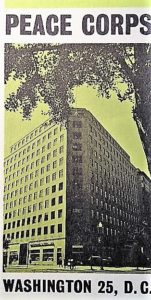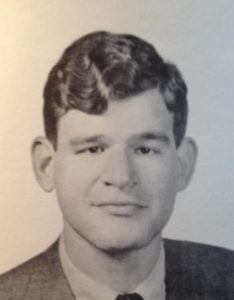William Josephson, First Peace Corps Lawyer
 In September, 1958, Bill Josephson went to England to write a doctoral dissertation in history at St. Antony’s College, one of the two graduate colleges at Oxford University. He set himself what he still describes as “a fascinating thesis problem: what were the other Americans, other than President Wilson and Colonel House, doing at the Paris Peace Conference in 1919?
In September, 1958, Bill Josephson went to England to write a doctoral dissertation in history at St. Antony’s College, one of the two graduate colleges at Oxford University. He set himself what he still describes as “a fascinating thesis problem: what were the other Americans, other than President Wilson and Colonel House, doing at the Paris Peace Conference in 1919?
“The American delegation included numbers of people who were to become first magnitude figures—Lippmann, Grew, Bullitt, Frankfurter, Dulles, Baruch”—but exactly what they were doing from day to day has by and large remained a mystery.”
Fascinating or not, the thesis was never completed because the young lawyer met Diana Hayward Bailey, a London girl whom he proceeded to court and marry.
On the other side of the world, one Earl Reynolds had just stated an anti-bomb demonstration by sailing his yacht, Phoenix, into the Pacific testing area. Just before leaving for England, Josephson had helped find him a lawyer.
Reynolds was tried and convicted while Josephson was still in England. In 1959, Josephson returned home to look for a job in Washington, and while awaiting his clearance he went to work briefly for an old friend, Joseph Rauh, former president of the Americans for Democratic Action. Rauh had conducted Reynold’s unsuccessful defense and was planning an appeal. Meanwhile, the defendant wanted to be released on bail so that he could take a teaching job in Japan.
Josephson argued for bail before Justice William O. Douglas and won Reynold’s release—the first time, recorded in history any way, that a defendant in a Federal criminal action was granted bail so that he could leave the country. In the five weeks while he was waiting to become Far East Regional Counsel for the International Cooperation Administration (ICA), Josephson had characteristically become involved in a case of absorbing legal interest.
Born in Newark and raised in South Orange, N.J. the 28-year-old Josephson doesn’t know why he became a lawyer except that “from the time I was a child, I knew that is what I would do.” With the help of a scholarship, he sailed through the University of Chicago in three years, including two summer sessions, and enrolled in Columbia Law School where he was later named an editor of the Columbia Law Review. After his graduation in 1955, he spent the summer in Europe at the Salzburg Seminar. He then joined one of New York’s most distinguished law firms—Paul, Weiss, Rifkind, Wharton & Garrison.
Josephson soon found himself working with Rauh to help defend Arthur Miller against contempt of Congress, charges growing out of the playwright’s refusal to testify concerning alleged left-wing colleagues. He worked on the immensely complicated transaction through which Hilton Hotels Corporation took over the Statler hotels. He helped to defend Lowe’s against a takeover attempt by a Canadian industrialist.
At ICA, Josephson met Warren Wiggins and assisted him in preparing his study of prospective Peace Corps policy entitled, “The Towering Task.”
Almost as a natural consequence, he was invited by Sargent Shriver to join the group which, in February, 1961, was laying the groundwork for the Peace Corps. Until May 1, he was the only lawyer in the new organization and he thus became the principal author of the President’s Executive order which brought the Peace Corps into existence.
“Shriver’s administrative policies are
enough to give a veteran bureaucrat
the willies. He expects top executives,
lawyers and educators to take a pay
cut to work for the Peace Corps.”
–W. B. Ragsdale, Jr.
in the Associated Press, 1961
No comments yet.
Add your comment